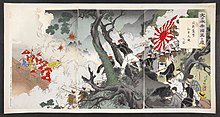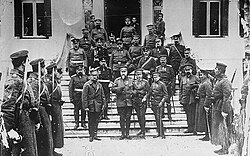
Back Eerste Chinees-Japannese Oorlog Afrikaans الحرب اليابانية الصينية الأولى Arabic Primer guerra sino-xaponesa AST Yaponiya–Çin müharibəsi (1894–1895) Azerbaijani چین-ژاپون ساواشی (۱۸۹۴—۱۸۹۵) AZB Першая япона-кітайская вайна Byelorussian Китайско-японска война (1894 – 1895) Bulgarian প্রথম চীন-জাপান যুদ্ধ Bengali/Bangla Primera Guerra sino-japonesa Catalan První čínsko-japonská válka Czech
| First Sino-Japanese War | |||||||||
|---|---|---|---|---|---|---|---|---|---|
| Part of the century of humiliation | |||||||||
| |||||||||
| |||||||||
| Belligerents | |||||||||
|
|
| ||||||||
| Commanders and leaders | |||||||||
| Strength | |||||||||
|
Within theatre of operations 180,310 bannermen 51,760 Green Standard 125,030 Trained men Total 357,100 |
| ||||||||
| Casualties and losses | |||||||||
|
|
Total: 17,069 casualties | ||||||||
| First Sino-Japanese War | |||||||||||||||
|---|---|---|---|---|---|---|---|---|---|---|---|---|---|---|---|
 | |||||||||||||||
| Chinese name | |||||||||||||||
| Traditional Chinese | 甲午戰爭 | ||||||||||||||
| Simplified Chinese | 甲午战争 | ||||||||||||||
| Literal meaning | War of Jiawu – referring to the year 1894 under the traditional sexagenary system | ||||||||||||||
| |||||||||||||||
| Japanese name | |||||||||||||||
| Hiragana | にっしんせんそう | ||||||||||||||
| Katakana | ニッシンセンソウ | ||||||||||||||
| Kyūjitai | 日清戰爭 | ||||||||||||||
| Shinjitai | 日清戦争 | ||||||||||||||
| Literal meaning | Japan–Qing War | ||||||||||||||
| |||||||||||||||
| Korean name | |||||||||||||||
| Hangul | 청일전쟁 | ||||||||||||||
| Hanja | 淸日戰爭 | ||||||||||||||
| Literal meaning | Qing–Japan War | ||||||||||||||
| |||||||||||||||
| Events leading to World War I |
|---|
 |
|
The First Sino-Japanese War (25 July 1894 – 17 April 1895) or the First China–Japan War was a conflict between the Qing dynasty and the Empire of Japan primarily over influence in Korea.[2] After more than six months of unbroken successes by Japanese land and naval forces and the loss of the port of Weihaiwei, the Qing government sued for peace in February 1895.
The war demonstrated the failure of the Qing dynasty's attempts to modernize its military and fend off threats to its sovereignty, especially when compared with Japan's successful Meiji Restoration. For the first time, regional dominance in East Asia shifted from China to Japan;[3] the prestige of the Qing dynasty, along with the classical tradition in China, suffered a major blow. The humiliating loss of Korea as a tributary state sparked an unprecedented public outcry. Within China, the defeat was a catalyst for a series of political upheavals led by Sun Yat-sen and Kang Youwei, culminating in the 1911 Revolution and ultimate end of dynastic rule in China.
The war is commonly known in China as the War of Jiawu (Chinese: 甲午戰爭; pinyin: Jiǎwǔ Zhànzhēng), referring to the year (1894) as named under the traditional sexagenary system of years. In Japan, it is called the Japan–Qing War (Japanese: 日清戦争, Hepburn: Nisshin sensō). In Korea, where much of the war took place, it is called the Qing–Japan War (Korean: 청일전쟁; Hanja: 淸日戰爭).
- ^ Jowett 2013, p. 37.
- ^ Kim, Samuel S. (2006). The Two Koreas and the Great Powers. Cambridge University Press. p. 2. doi:10.1017/cbo9780511510496. ISBN 978-0-521-66899-6.
Japan was at the forefront of hegemonic wars in a quest to extend the Japanese hegemony over Korea to the entire Asia-Pacific region – the Sino–Japanese War of 1894–95 to gain dominance in Korea.
- ^ Paine 2003, p. 3.
© MMXXIII Rich X Search. We shall prevail. All rights reserved. Rich X Search


